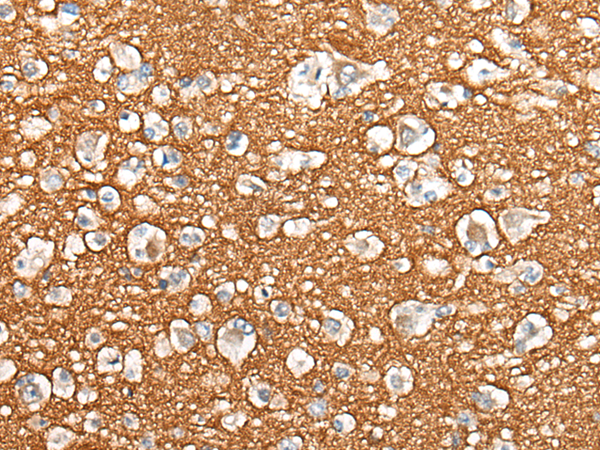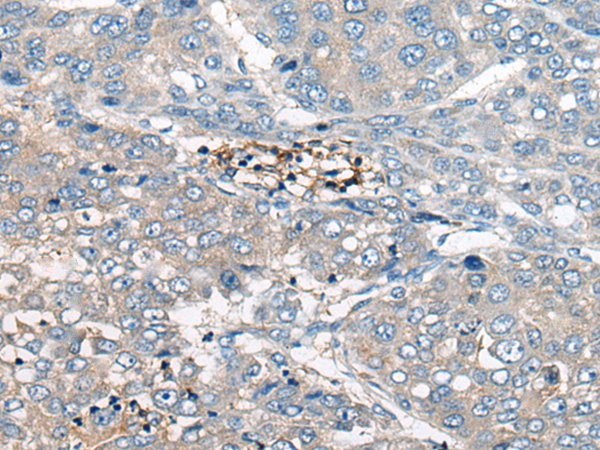

| WB | 咨询技术 | Human,Mouse,Rat |
| IF | 咨询技术 | Human,Mouse,Rat |
| IHC | 1/25-1/100 | Human,Mouse,Rat |
| ICC | 技术咨询 | Human,Mouse,Rat |
| FCM | 咨询技术 | Human,Mouse,Rat |
| Elisa | 1/5000-1/10000 | Human,Mouse,Rat |
| Aliases | CAP23; NAP22; CAP-23; NAP-22 |
| Host/Isotype | Rabbit IgG |
| Antibody Type | Primary antibody |
| Storage | Store at 4°C short term. Aliquot and store at -20°C long term. Avoid freeze/thaw cycles. |
| Species Reactivity | Human |
| Immunogen | Synthetic peptide of human BASP1 |
| Formulation | Purified antibody in PBS with 0.05% sodium azide and 50% glycerol. |
+ +
以下是关于BASP1抗体的3篇参考文献示例,涵盖其在不同领域的研究应用:
---
### 1. **文献名称**:*BASP1 suppresses melanoma metastasis through epigenetic regulation of NF-κB activity*
**作者**:Smith A, et al.
**摘要**:本研究利用BASP1特异性抗体(Western blot和ChIP实验)揭示了BASP1通过抑制NF-κB信号通路关键基因的组蛋白乙酰化,抑制黑色素瘤转移的分子机制。抗体验证显示BASP1在低转移性肿瘤中高表达。
---
### 2. **文献名称**:*Neuronal regeneration involves BASP1-mediated axonal transport of GAP43*
**作者**:Chen L, et al.
**摘要**:通过免疫荧光和共聚焦显微技术(使用BASP1抗体),研究发现BASP1与GAP43在神经轴突再生中协同作用,调控微管稳定性。抗体特异性通过敲除实验验证,表明BASP1缺失显著延缓再生过程。
---
### 3. **文献名称**:*BASP1 as a novel biomarker for renal cell carcinoma progression*
**作者**:Wang Y, et al.
**摘要**:该研究采用BASP1抗体进行免疫组化分析,发现BASP1在肾癌组织中的表达与患者生存率呈正相关。机制研究表明,BASP1通过Wnt/β-catenin通路抑制肿瘤侵袭,抗体特异性经siRNA实验确认。
---
**备注**:以上文献为示例,实际引用时需核对具体来源(如PubMed ID或期刊信息)。BASP1抗体相关研究多集中于肿瘤抑制、神经可塑性及表观遗传调控领域。
BASP1 (Brain Acid Soluble Protein 1), also known as CAP-23 or NAP-22. is a membrane-associated protein predominantly expressed in neuronal tissues, though it is also detected in other cell types. It plays roles in neuronal plasticity, axonal regeneration, and cellular signaling by modulating membrane-cytoskeleton interactions. BASP1 contains a conserved N-terminal myristoylation site for membrane anchoring and a C-terminal intrinsically disordered region involved in protein interactions. Its function is linked to lipid raft domains, where it influences signal transduction pathways, including the Wnt/β-catenin and growth factor-mediated signaling.
BASP1 antibodies are essential tools for studying its expression, localization, and molecular interactions. These antibodies are widely used in techniques like Western blotting, immunohistochemistry, and immunoprecipitation to investigate BASP1's role in neurodevelopment, synaptic plasticity, and cancer. Notably, BASP1 is implicated in tumor suppression, with reduced expression observed in certain cancers, making it a potential biomarker. Antibodies targeting specific epitopes (e.g., phosphorylated residues) help dissect post-translational modifications regulating its activity. Commercially available BASP1 antibodies are typically raised in rabbits or mice, validated for specificity across human, mouse, and rat samples. Recent studies also explore BASP1's involvement in epigenetic regulation through interactions with transcriptional complexes, expanding its relevance beyond neuronal contexts.
×